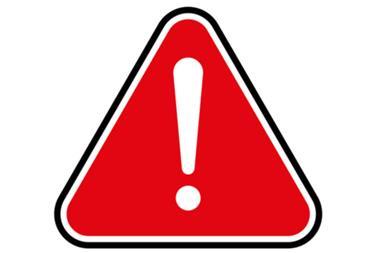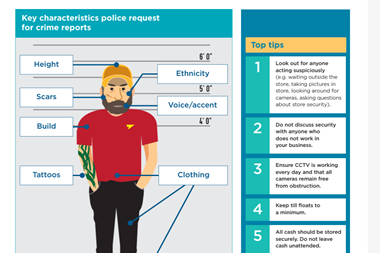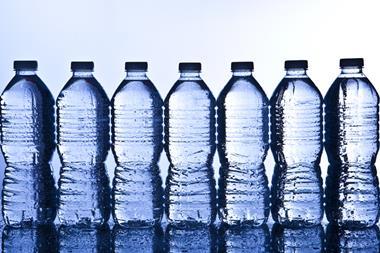Are your chillers freezing your profits? C-Store looks at ways to keep your energy consumption under control
One of the lessons of last summer's record temperatures was that your customers won't put up with anything less than nicely chilled food and drinks when the mercury rises. They come to you, their main source of impulse purchases, looking for instant relief from the heat, and it seems that everything from fruit to confectionery, and every single canned or bottled drink you stock, belongs in the cold cabinets these days.
The chilling fact is that if more of your shelves are piled high with cold and frozen ranges, your power bills are going to head for the roof too.
Fortunately there are several small steps you can take to keep your consumption down, and do your bit for the environment, not to mention your profits, at the same time.
Austin Keens, refrigeration services manager at cabinet manufacturer Valera, says that the effective working life of a chiller cabinet can be up to 10 years, if it's properly looked after; anything longer than that and you'll be ramping up your power bills unnecessarily. "The key to keeping your kit running efficiently over its whole life is to carry out some simple maintenance," he says. "The number one thing you can do yourself is clean the condenser." This is the heat exchanger, usually found behind a grill on the back of a cabinet, and any build up of dust and dirt will mean that it's not doing its job as well as it should. "Use a soft brush and a vacuum cleaner every couple of months and it will make a huge difference to energy efficiency," says Keens. "Clean shops are actually the worst - if you dust regularly you'll push a lot of dirt into the air, and this will get sucked into your cabinets and end up stuck on the condenser."
Equally important is keeping the equipment at the right temperature. "There's no benefit in running it too cold. Chilled cabinets are designed to operate at 3-5degC and freezers at about -24degC, so don't fiddle with the controls - and remember, they are designed to hold products at a temperature, not to cool them down, so if you want to keep your running costs down, don't load warm products into your chillers." There's also the danger that ice will form on the evaporator (think of the freezer compartment in your fridge at home) and that, too, will significantly affect your power consumption.
If your chillers have night blinds - and they should - do use them. Many open cabinets have a curtain of air which keeps the cold where it should be, on the food. If there's a draught from the door, the air conditioning or a fan, the air curtain won't work properly and again, the poor cabinet will work harder and suck up a lot more juice to do its job.
If your chillers have doors, they are there for a reason. "Keep them closed," says Keens, "And make a point of checking the seals. If they perish or get torn they'll leak." Sticky spills, such as orange juice, will set like glue on the door's rubber gaskets and if you don't spot them, the seal will split the next time someone opens the door.
Keens' final recommendation is to invest in a planned preventative maintenance programme. It may sound like one of those add-ons suppliers throw at you when you buy a new TV or microwave, but in this case the extra outlay may be worthwhile. "Most fridges break down because of small problems which have been neglected," he says. "If you come in in the morning and find a freezer has gone down, you're facing lost stock and even closure. A twice-yearly visit from an engineer, just to maintain the motors, clean the coils and check the gaskets, should prevent this, and also keep your equipment running as efficiently as it should."
A quick checklist for easy energy-saving around the store
Night blinds
They're there for a reason! Use them. Old-style cabinets with plastic strips need them to operate efficiently. Newer displays have an air curtain to keep the cold air in; this will be disturbed by direct draughts from doors or fans.
Sunlight
If you're cooling bottles you don't want to be heating them at the same time. Avoid placing chilled stock in direct sunlight.
Lights
Lighting accounts for about 35% of your power consumption. New fluorescent bulbs will slash your bills - but don't forget to turn them off and use natural light if you can. Timers will ensure nothing stays on too long.
Circulation
Chillers emit hot air - but if it can't disperse, you'll end up paying more to keep your cool. Keep the condenser well ventilated and clean it every couple of months.
Windows
Are your chiller cabinets in the hottest part of the store? They will have work a lot harder if they are. If you are reluctant to move them to a shadier spot, think about blinds or vinyls which will stop solar gain but not block out
the light.
Check temperature
Don't turn the thermostat down more than you need to. Every unnecessary degree centigrade of cooling adds up to 4% to the unit's power consumption. Chilled display equipment is designed to hold products at a temperature, not to cool them down, so try not to put warm items into the chiller.
Air conditioning
Don't block the flow: this example is an expensive way of chilling wine. And lock the controls so staff don't meddle with the temperature. Constant swinging from hot to cold - or leaving the unit on after hours - will cost you a fortune.
One of the lessons of last summer's record temperatures was that your customers won't put up with anything less than nicely chilled food and drinks when the mercury rises. They come to you, their main source of impulse purchases, looking for instant relief from the heat, and it seems that everything from fruit to confectionery, and every single canned or bottled drink you stock, belongs in the cold cabinets these days.
The chilling fact is that if more of your shelves are piled high with cold and frozen ranges, your power bills are going to head for the roof too.
Fortunately there are several small steps you can take to keep your consumption down, and do your bit for the environment, not to mention your profits, at the same time.
Austin Keens, refrigeration services manager at cabinet manufacturer Valera, says that the effective working life of a chiller cabinet can be up to 10 years, if it's properly looked after; anything longer than that and you'll be ramping up your power bills unnecessarily. "The key to keeping your kit running efficiently over its whole life is to carry out some simple maintenance," he says. "The number one thing you can do yourself is clean the condenser." This is the heat exchanger, usually found behind a grill on the back of a cabinet, and any build up of dust and dirt will mean that it's not doing its job as well as it should. "Use a soft brush and a vacuum cleaner every couple of months and it will make a huge difference to energy efficiency," says Keens. "Clean shops are actually the worst - if you dust regularly you'll push a lot of dirt into the air, and this will get sucked into your cabinets and end up stuck on the condenser."
Equally important is keeping the equipment at the right temperature. "There's no benefit in running it too cold. Chilled cabinets are designed to operate at 3-5degC and freezers at about -24degC, so don't fiddle with the controls - and remember, they are designed to hold products at a temperature, not to cool them down, so if you want to keep your running costs down, don't load warm products into your chillers." There's also the danger that ice will form on the evaporator (think of the freezer compartment in your fridge at home) and that, too, will significantly affect your power consumption.
If your chillers have night blinds - and they should - do use them. Many open cabinets have a curtain of air which keeps the cold where it should be, on the food. If there's a draught from the door, the air conditioning or a fan, the air curtain won't work properly and again, the poor cabinet will work harder and suck up a lot more juice to do its job.
If your chillers have doors, they are there for a reason. "Keep them closed," says Keens, "And make a point of checking the seals. If they perish or get torn they'll leak." Sticky spills, such as orange juice, will set like glue on the door's rubber gaskets and if you don't spot them, the seal will split the next time someone opens the door.
Keens' final recommendation is to invest in a planned preventative maintenance programme. It may sound like one of those add-ons suppliers throw at you when you buy a new TV or microwave, but in this case the extra outlay may be worthwhile. "Most fridges break down because of small problems which have been neglected," he says. "If you come in in the morning and find a freezer has gone down, you're facing lost stock and even closure. A twice-yearly visit from an engineer, just to maintain the motors, clean the coils and check the gaskets, should prevent this, and also keep your equipment running as efficiently as it should."
Simple savings
A quick checklist for easy energy-saving around the store
Night blinds
They're there for a reason! Use them. Old-style cabinets with plastic strips need them to operate efficiently. Newer displays have an air curtain to keep the cold air in; this will be disturbed by direct draughts from doors or fans.
Sunlight
If you're cooling bottles you don't want to be heating them at the same time. Avoid placing chilled stock in direct sunlight.
Lights
Lighting accounts for about 35% of your power consumption. New fluorescent bulbs will slash your bills - but don't forget to turn them off and use natural light if you can. Timers will ensure nothing stays on too long.
Circulation
Chillers emit hot air - but if it can't disperse, you'll end up paying more to keep your cool. Keep the condenser well ventilated and clean it every couple of months.
Windows
Are your chiller cabinets in the hottest part of the store? They will have work a lot harder if they are. If you are reluctant to move them to a shadier spot, think about blinds or vinyls which will stop solar gain but not block out
the light.
Check temperature
Don't turn the thermostat down more than you need to. Every unnecessary degree centigrade of cooling adds up to 4% to the unit's power consumption. Chilled display equipment is designed to hold products at a temperature, not to cool them down, so try not to put warm items into the chiller.
Air conditioning
Don't block the flow: this example is an expensive way of chilling wine. And lock the controls so staff don't meddle with the temperature. Constant swinging from hot to cold - or leaving the unit on after hours - will cost you a fortune.































No comments yet